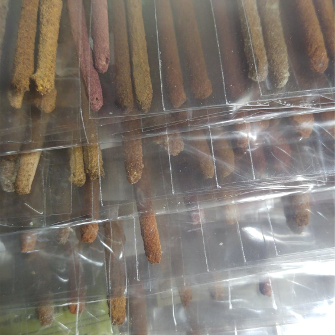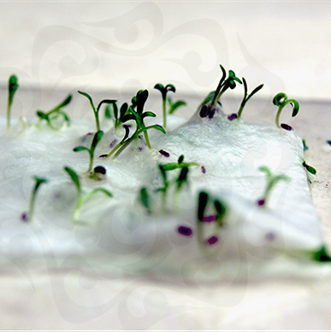Compostable Bag - made from corn cellulose, not plastic!
Did you know that our bags are NOT made of plastic? They are actually made from Polylactide Acid (known as PLA), a biopolymer resin. PLA is a plant-based plastic made from dextrose (sugar) derived from corn. Here are the basics of how it is done…
• Corn is steeped in sulpher dioxide (made from burning natural sulfur) and hot water to loosen the molecular bonds in the kernels.
• The mixture is ground up and spun quickly to separate the oil from the starch.
• Dextrose is extracted from the starch through a process called hydrolysis (a reaction involving the breaking of a bond in a molecule using water – like salt dissolving in water).
• The dextrose is fermented to form lactic acid.
• The lactic acid goes through a process called electrodialysis (the same process used to desalinate seawater), resulting in lactide.
• Finally, the lactide is treated with a catalyst (a substance that speeds up a chemical reaction, but is not consumed by the reaction), opening the molecules and linking them into long chains (aka ‘polymers’) consisting of tens of thousands of units linked together.
All plastics are made from these long chains of molecules, but in this case, the polymer is created from molecules from corn instead of molecules from petroleum.
Not only does PLA come from a natural, renewable resource, but the production also uses less fossil fuels and emits less greenhouse gas. It can be cleanly incinerated, industrially composted, or even converted back into lactic acid to create more biopolymer.


Info Tag - Seeded Paper coloured in-house with natural dyes like fruit or veggie juice
It can be tough to nurse the live seeds through germination into fully grown plants but every batch of paper contains enough viable seeds to have the potential for growth.
We recommend that you do the following; take each tag, place it into an airtight zip lock plastic sandwich bag, place a tablespoon of water (or enough to fully saturate the paper) in the bag and then seal the bag and trap a bit of air inside it so it forms a bubble to keep both sides of the bag from touching. If you do this in a room that is has an ambient temperature of at least 72 degrees, and allow the bag to be touched by sunlight for a few hours each day, you will see evidence of the seeds growth within 10 days time. Once you see the sprout's roots searching for soil, transfer the paper from the bag into a pot (or garden) with a light covering of soil and continue nursing the seedlings along by daily watering.
Top Tag – recycled kraft paper – recycle or compost
Ribbon – plant fiber, also known as raffia – compost
